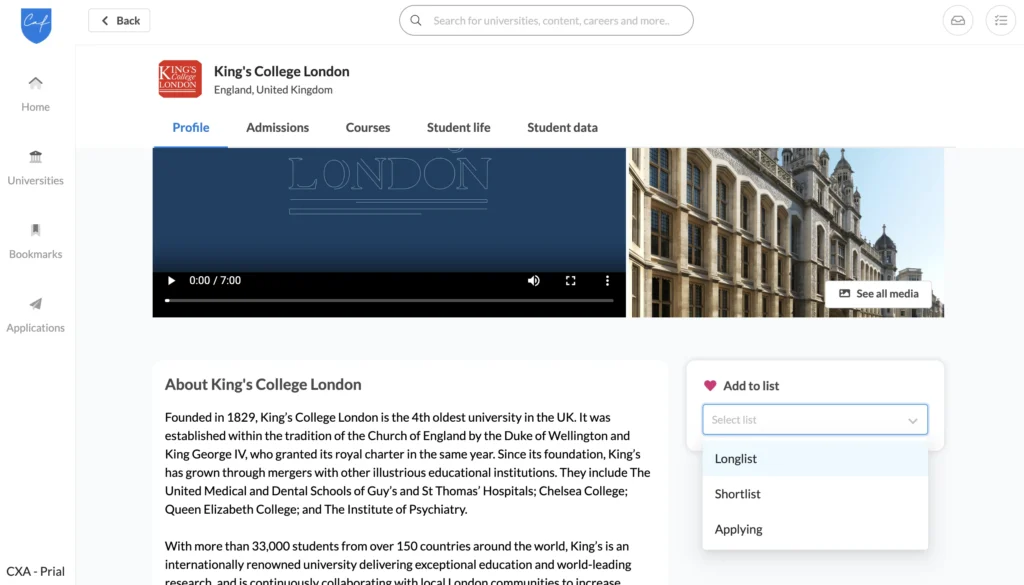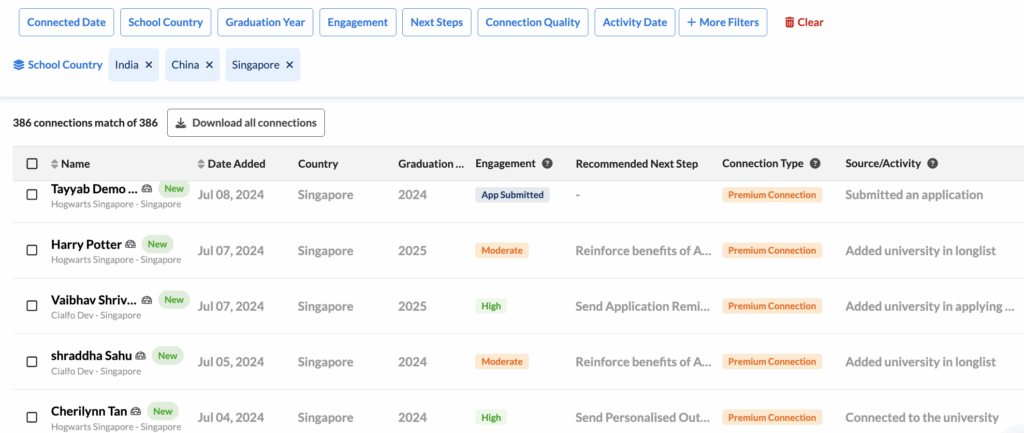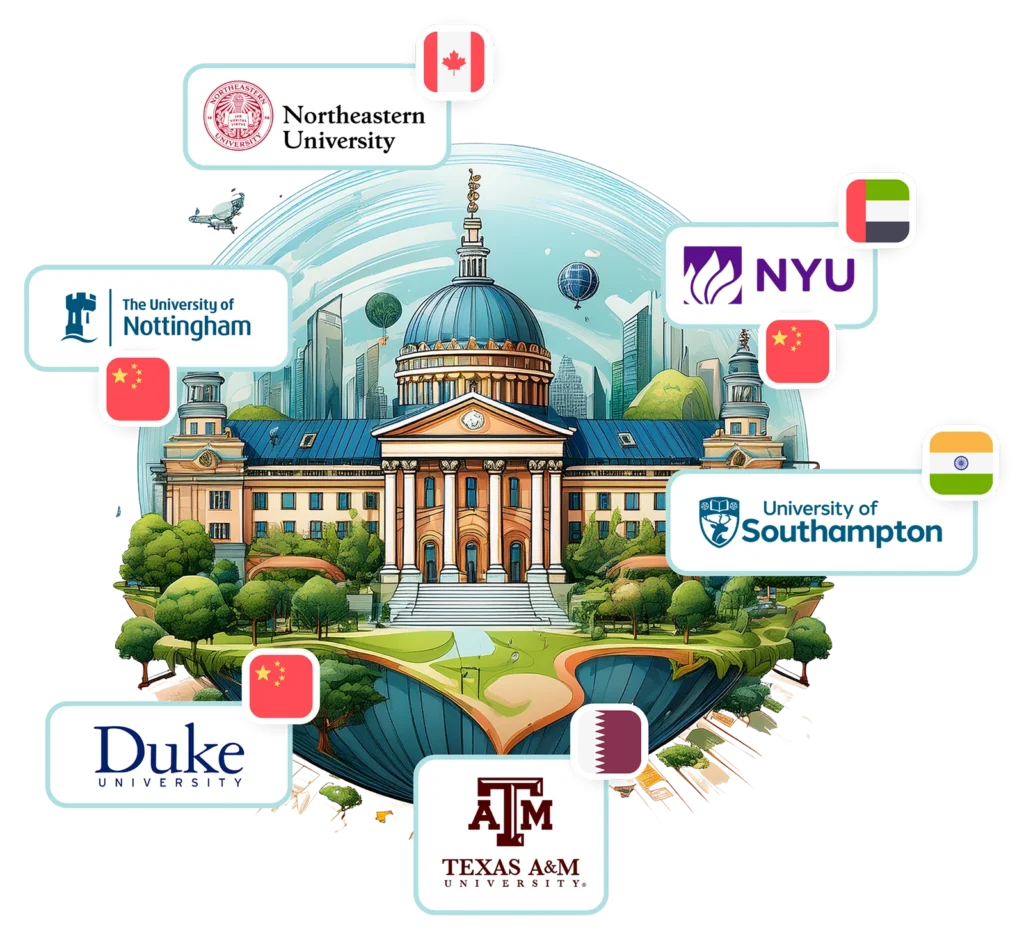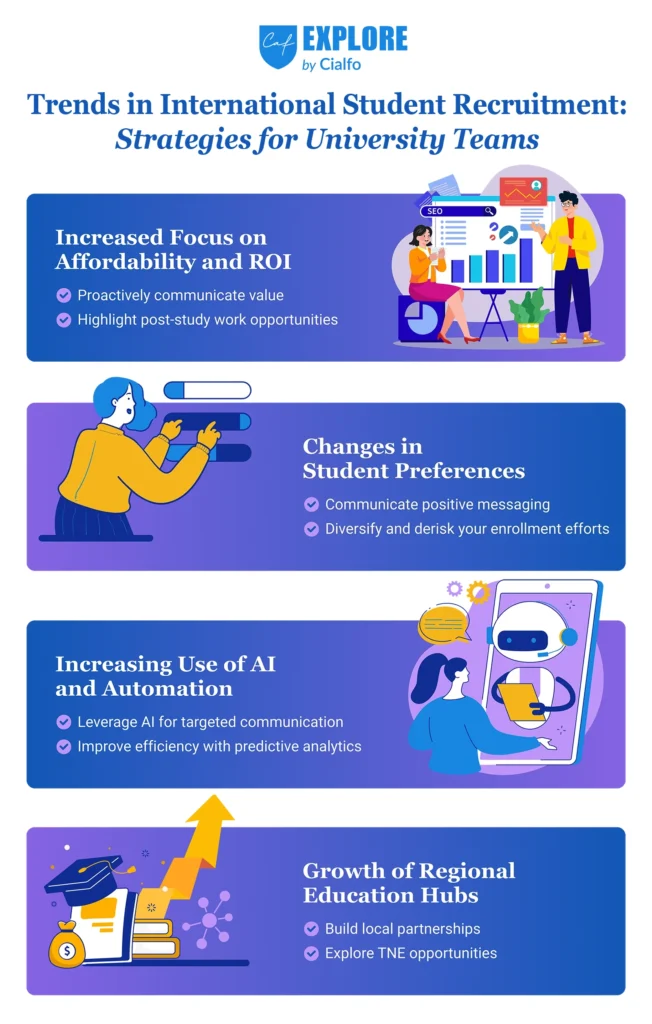The international student recruitment landscape has undergone significant changes in recent years. Today, university enrollment and recruitment teams must stay more agile than ever to respond and adapt to evolving policies, global economic factors, technological advancements, and changing student preferences.
Here’s a look at some of the most important student recruitment trends in undergraduate education, and our predictions for how things will play out. We’ll also share strategies universities can leverage to remain competitive against this background.
Top 4 Trends in International Student Recruitment
Key Takeaways
The world of international higher education continues to change. University marketing and student enrollment teams have to stay agile in the face of the constantly evolving realities.
We talk about four of the most important student recruitment trends to be aware of:
- ROI is everything: Your university programs are increasingly being evaluated on parameters like costs and employability
- Uncertainty will continue to impact student decisions: Doubts about visa and immigration rules and the current geo-political climate will weigh on the minds of students and their families
- AI is going mainstream: The proliferation of AI technologies offers opportunities for improving efficiency in operations, as well as more personalized outreach
- Regional education hubs are growing stronger: The search for affordable, quality education is nudging international students toward newer destinations
Read on to see your university can make the most of opportunities and compete effectively.
Focus on Affordability and ROI
The altered economic landscape of the last few years will continue to be a major factor influencing students’ choice of study avenues and destinations.
With rising costs, students and families will be looking for universities that provide the best value for money. Your university has the opportunity here to adapt fast and stay competitive.

Did You Know: Universities UK surveyed 43 higher education institutions. 86% reported demand for career and employability services from international students as ‘very high’ or ‘fairly high’
The demand for return on investment (ROI) in education will intensify as students and families become more financially cautious. Prospective students will increasingly evaluate programs based on job prospects, salary potential, and employability.
Institutions that proactively address these financial challenges will have a stronger chance of attracting international students despite economic uncertainties.
For example, Coventry University partners with the automotive group Geely to provide work and internship opportunities in design, engineering, and manufacturing fields.
Our recommendation for universities
- Create and promote a variety of financial aid options to cost-conscious international students. This will keep your university and programs in the consideration set. Besides scholarships and work-study opportunities, you could introduce flexible payment options and installments. Many universities are doing this successfully, for example, the University of Connecticut, Tennessee State University, the University of Virginia, Reed College, and others
- Offer hybrid study options to reduce living costs for international students
- Highlight your career services and industry partnerships. Universities often have very robust departments doing great work here. However, they may not think of focusing on these in their enrollment marketing strategies. Today, the quality of internships and post-study work options can be a deal-breaker for students evaluating universities and programs
- Plan marketing campaigns with partners like Explore by Cialfo to get access to engaged and high-trust student communities
Explore Tip: Universities can showcase their scholarships, affordable programs, and value-based offerings directly through Explore, allowing students to find cost-effective options. Contact us to learn how you can leverage Explore to highlight your offerings.

Changes in Student Preferences Due to Policy Shifts
Did You Know: A 2024 study found that 82% of senior university leaders in the UK, Australia, and Canada feel their internationalization attempts are being affected by government policy decisions.
It’s a world of geo-political uncertainties, coupled with changing immigration and work policies in various destination countries. This has created anxiety among international students considering their study abroad options.

Countries with (real or perceived) stringent visa regulations will continue to see a decline in applications as students opt for destinations with easier immigration rules.
Universities in countries with stable and favorable visa policies will attract more international students in the next few years.
Our recommendation for universities
- Actively send out positive messaging about welcoming international students, to allay uncertainties
- Stay agile and responsive to changing circumstances and policies that can impact international student recruitment trends
- Provide active and transparent visa guidance to help guide international students through the uncertainty
- Communicate proactively with your target markets to counter any possible misinformation
- Diversify your international student recruitment efforts and markets to derisk against changing student mobility patterns
Explore Tip: You can run digital campaigns on the Explore platform to counter misinformation and engage with qualified students from 100+ countries

Increasing Use of AI and Automation
Artificial intelligence and other modern technologies are already changing how universities attract, engage, and support international students. This will increase in the next few years, making student recruitment more data-driven.

Higher education institutions are adopting technologies such as chatbots to answer students’ queries and enable 24/7 engagement. In the future, chatbots and virtual assistants will not just resolve queries but also offer personalized suggestions about programs and classes based on a student’s interests and academic background.
Predictive analytics powered by AI will help universities analyze data to forecast enrollment trends, identify high-potential applicants, and make the best use of their resources.
Explore Tip: The Explore platform uses AI to inform universities of the likelihood of students enrolling in their programs, so they can focus their efforts. The student-facing platform, Cialfo, also advises students of their likelihood of receiving an offer from your university.
At the same time, students are increasingly turning to generative AI to write their college essays and personal statements. The traditional modes of screening college applications are in for an overhaul, with universities needing to rethink existing patterns and ways of assessing students.
Our recommendation for universities
- Keep pace with the digitalizing world by strategically incorporating AI and automation into your university marketing, recruitment, and admissions processes. For example, you could experiment with virtual reality experiences to attract potential students, deploy chatbots to answer applicant questions, etc.
- Support the efforts of your recruitment teams by providing them with data and insights from AI analytics tools, saving them time and improving their effectiveness
- Personalize your student outreach and marketing efforts with the help of AI, ensuring you spend your budget where it will be the most impactful. For example, with inputs from Explore’s AI, you can target high-potential students with a demonstrated interest to update them about your scholarships and other financial aid options. Similarly, the platform can show you applicants with low chances of enrollment, giving you an opportunity to run a targeted ‘win back’ campaign
Explore Tip: Use Explore’s automated communication tools to keep students engaged at every stage of the recruitment process. Automate reminders for application deadlines, events, and content delivery to keep students informed.
The Growth of Regional Education Hubs
Rising tuition costs and other restrictions in traditional higher education destinations like the US, UK, and Canada have nudged some international students towards alternatives.

The next few years will see the growth of these regional education hubs. Countries such as Singapore, Germany, Ireland, the Netherlands, the UAE, New Zealand, etc. will attract growing numbers of applicants due to the offer of affordable and quality education.
Increasing numbers of international students will opt for destinations with easier visa availability, affordable education, and opportunities for post-study work.
Universities in the traditional study destinations will face greater competition to retain their share of students.
However, this is also an opportunity to build partnerships in these regional hubs to expand your reach. Many universities in the UK, US, Australia, etc. are already expanding their operational transnationally.
Examples:
- University of Southampton → New Delhi, India
- NYU → Abu Dhabi, UAE and Shanghai, China
- Northeastern University → Toronto, Canada
- Duke University → Kunshan, China
- Texas A&M University → Ar Rayyan, Qatar
- University of Nottingham → Ningbo, China
Our recommendation for universities
- Establish collaborative partnerships with institutions in target countries to grow your reach
- Consider various options for transnational education, such as dual degree programs, international branch campuses, online learning, etc.
- Ensure dedicated support to students in these campuses and partner programs to ensure success
Looking Ahead: The Future of International Student Recruitment
As we look at international student recruitment trends, it is evident that adaptability and innovation will be key to long-term success.

Affordability and ROI will remain central concerns, shaping students’ choices and pushing institutions to offer more financial flexibility and career-driven programs. Shifting policies and the rise of regional education hubs will continue to impact student mobility trends. Universities must proactively communicate with their prospective students in this scenario.
Looking ahead, the institutions that thrive will be those that prioritize student-centric strategies, international partnerships, and technology to enhance engagement.
Is your university looking to grow its international footprint in the wake of current student recruitment trends? A global platform like Explore by Cialfo is the ideal strategic partner in this.
Request a demo today to learn more.


